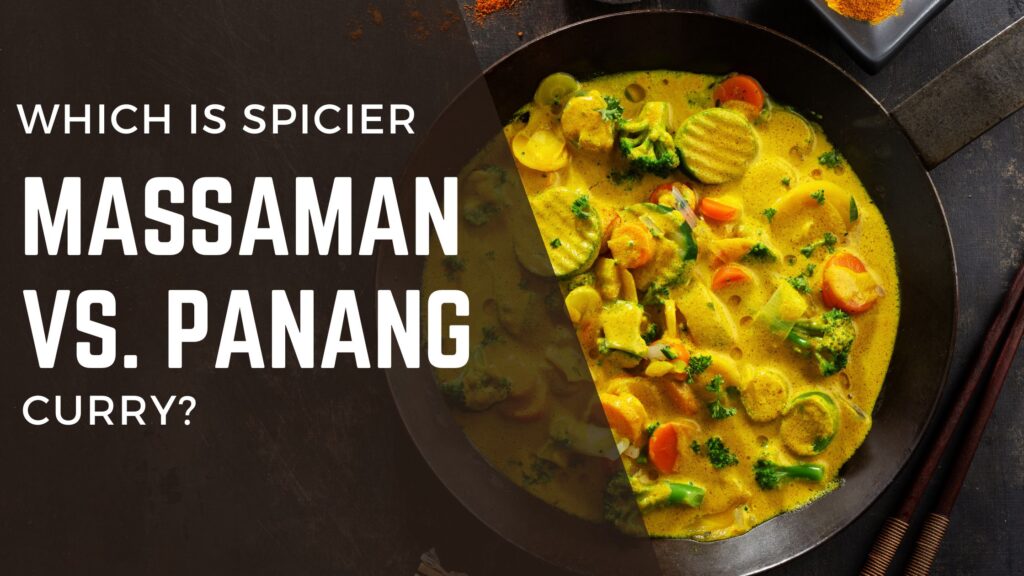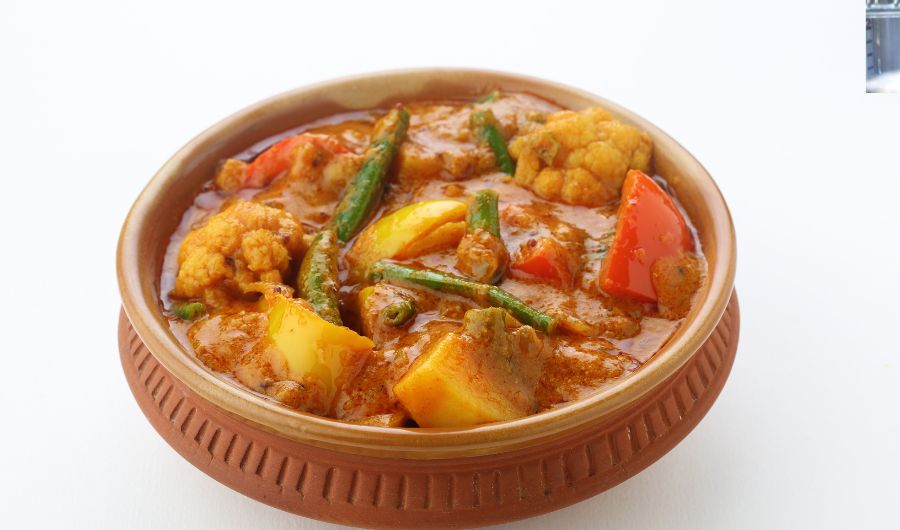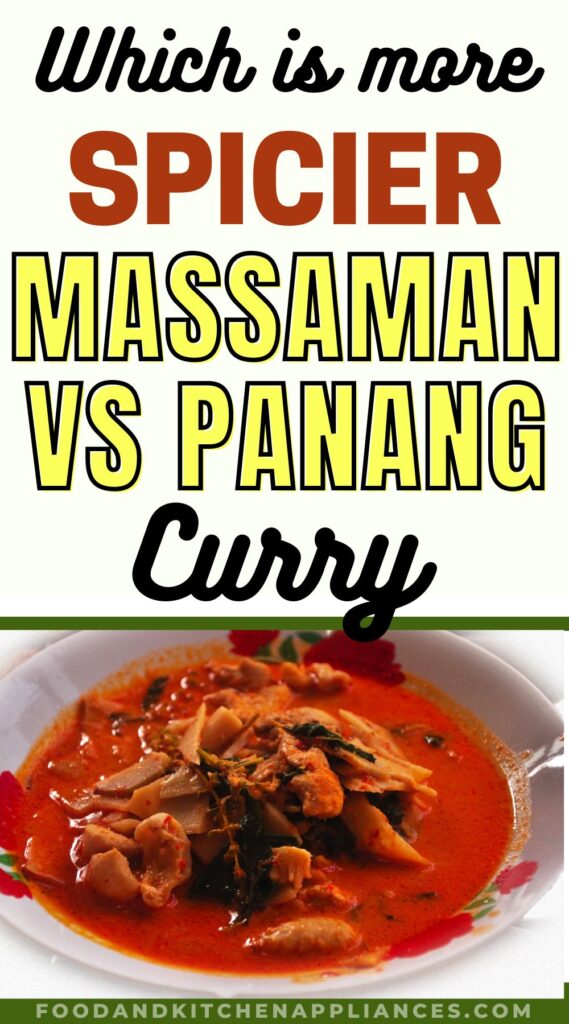Regarding Thai curries, Massaman and Panang are two of the most popular options. Both curries are rich in flavor and offer a unique taste experience. If you’re wondering which one to try, it’s essential to understand the differences between them.

Massaman vs. Panang Curry
Massaman curry is mild, creamy, and typically made with potatoes, peanuts, and cinnamon. It has a slightly sweet taste and is often served with rice.
On the other hand, Panang curry is a spicy, tangy curry that’s made with red curry paste, coconut milk, and kaffir lime leaves. It has a thicker consistency than Massaman curry and is often served with steamed vegetables or noodles.
Overall, both curries have their unique taste and texture. You can’t go wrong with Massaman or Panang, whether you prefer a mild, creamy curry or a spicy, tangy one. So, why not try both and see which one you like best?
Ingredients
Massaman Curry Ingredients
When it comes to Massaman curry, the ingredients make it stand out from other curries. This dish’s unique blend of spices gives it a distinctive flavor. Here are the key ingredients you’ll need to make Massaman curry:
- Meat: Chicken, beef, or lamb are commonly used in Massaman curry. You can make it vegetarian or vegan using Paneer or Tofu instead of meat.
- Massaman curry paste: This paste typically contains a blend of spices, including cumin, coriander, cinnamon, cardamom, and nutmeg.
- Coconut milk: This gives the curry a creamy texture and balances the spices.
- Potatoes: These are a key ingredient in Massaman curry and help to thicken the sauce.
- Peanuts: Roasted peanuts are often added to the curry for a crunchy texture and nutty flavor.
- Fish sauce adds saltiness to the dish and helps balance the coconut milk’s sweetness.
- Palm sugar: This is used to sweeten the curry and balance out the spices.
Panang Curry Ingredients
Panang curry is another popular Thai curry with a slightly different flavor than Massaman curry. Here are the key ingredients you’ll need to make Panang curry:
- Meat: Chicken, beef, or shrimp are commonly used in Panang curry. Again you can use Tofu or Paneer to make it vegetarian or vegan.
- Panang curry paste: This paste typically contains a blend of spices, including galangal, lemongrass, kaffir lime leaves, and chili peppers.
- Coconut milk: This gives the curry a creamy texture and balances the spices.
- Kaffir lime leaves: These are a vital ingredient in Panang curry and give it its distinctive flavor.
- Fish sauce adds saltiness to the dish and helps balance the coconut milk’s sweetness.
- Palm sugar: This is used to sweeten the curry and balance out the spices.
Overall, Massaman and Panang curries share common ingredients like coconut milk, fish sauce, and palm sugar. However, the spices and herbs used in each curry give them a distinct flavor profile.
Preparation
Massaman Curry Preparation
To prepare Massaman Curry, you will need to gather the following ingredients:
- 1 pound Tofu or Paneer ( Or meat of your choice)
- 2 cans of coconut milk
- 2 tablespoons Massaman Curry paste
- 2 potatoes
- 1 onion
- 1 tablespoon tamarind paste
- 1 tablespoon palm sugar
- 1 tablespoon vegan fish sauce
- 1/2 cup roasted peanuts
- Begin by peeling and cutting the potatoes into bite-sized pieces.
- Cut the onion into thin slices.
Cut the tofu or paneer into bite-sized pieces as well.
Heat up a pot or wok over medium-high heat and add the coconut milk and Massaman Curry paste.
Stir until the paste is dissolved in the coconut milk. Add the Tofu or paneer and cook until it is browned on all sides. Add the potatoes and onions and stir until they are coated in the curry sauce.
Add the tamarind paste, palm sugar, and fish sauce. Stir and let it simmer for about 20 minutes or until the potatoes are cooked.
Add the roasted peanuts and stir. Serve with rice.
Panang Curry Preparation
To prepare Panang Curry, you will need to gather the following ingredients:
- 1 pound paneer or tofu
- 2 cans of coconut milk
- 2 tablespoons Panang Curry paste
- 1 red bell pepper
- 1 tablespoon vegan fish sauce
- 1 tablespoon palm sugar
- 1/2 cup roasted peanuts
Begin by cutting the red bell pepper into thin slices. Cut the paneer or Tofu into bite-sized pieces.
Heat up a pot or wok over medium-high heat and add the coconut milk and Panang Curry paste. Stir until the paste is dissolved in the coconut milk. Add the Paneer or Tofu and cook.
Add the red bell pepper and stir until it is coated in the curry sauce. Add the vegan fish sauce and palm sugar.
Stir and let it simmer for about 20 minutes or until the sauce thickens. Add the roasted peanuts at the end and stir.
Flavor
Regarding flavor, Massaman Curry and Panang Curry are delicious and unique in their ways.
Massaman Curry Flavor
Massaman Curry is known for its mild and slightly sweet flavor. The dish is made with a blend of spices, including cinnamon, cardamom, and nutmeg, which give it a warm and comforting taste. The curry paste used in Massaman Curry also includes peanuts and tamarind, adding a subtle nutty flavor and a hint of sourness. Adding coconut milk gives the curry a creamy and slightly sweet taste that balances out the spices and creates a rich and satisfying flavor.
When you taste Massaman Curry, you’ll notice the complexity of the flavors and how they blend to create a harmonious taste.
The sweetness of the curry is not overpowering but instead acts as a complement to the other flavors in the dish.
Peanuts and tamarind add a unique twist to the curry, making it stand out from other Thai curries.
Overall, Massaman Curry has a comforting and mild flavor that is perfect for those who prefer a less spicy dish. It’s an excellent option for those who want to try Thai curry but are hesitant about the spiciness.
Panang Curry Flavor
It is typically milder than other Thai curries like red or green curry, but it still packs a lot of taste.
The flavor profile of Panang curry can be described as a harmonious combination of sweet, savory, and slightly spicy elements.
Panang curry paste forms the base of the dish. It contains a blend of aromatic ingredients such as shallots, garlic, lemongrass, galangal (a type of ginger), kaffir lime zest, and various spices like coriander, cumin, and cardamom. These ingredients create a fragrant and flavorful foundation.
Panang curry gets its creamy consistency from adding rich and creamy coconut milk. The coconut milk adds a slightly sweet and nutty flavor to the dish, balancing the spiciness.
Spice Level
Massaman Curry Spice Level
When it comes to spice level, Massaman Curry is generally considered to be milder than Panang Curry.
This is because Massaman Curry typically uses fewer chilies and has a sweeter taste due to the addition of ingredients such as cinnamon, nutmeg, and cloves.
However, the spice level can vary depending on the recipe and the chef’s preference. Some recipes may call for more chilies or use spicier varieties, resulting in a hotter dish.

Panang Curry Spice Level
Panang Curry is known for its spiciness and is typically hotter than Massaman Curry. This is because it uses more chilies and has a thicker, creamier sauce made with coconut milk. The curry paste used in Panang Curry also contains more spices and herbs, such as lemongrass, galangal, and kaffir lime leaves, which contribute to its bold flavor and heat.
When ordering Panang Curry at a restaurant, it’s essential to ask the server about the spice level and specify your preference.
Some restaurants may offer different levels of spiciness, ranging from mild to extra spicy, so be sure to communicate your desired level of heat.
Overall, the spice level of Massaman Curry and Panang Curry can vary depending on the recipe and personal preference.
Massaman Curry may be a better option for milder dishes, while those who enjoy spicier food may prefer Panang Curry.
Panang curry flavor
Panang curry is a famous Thai curry with a rich and flavorful taste. It is known for its creamy, slightly sweet, and moderately spicy flavor profile. Here are some key characteristics and ingredients that contribute to the distinctive panang curry flavor:
- Curry Paste: Panang curry paste forms the base of the dish and contains a combination of ingredients such as dried red chili peppers, shallots, garlic, lemongrass, galangal (Thai ginger), coriander seeds, cumin, shrimp paste, and various aromatic spices. The paste is typically fried in oil to release its flavors before adding other ingredients.
- Coconut Milk is essential to panang curry, giving it a creamy and luxurious texture. The coconut milk’s richness helps balance the curry paste’s spiciness and adds a subtle sweetness.
- Kaffir Lime Leaves: Kaffir lime leaves are often used in panang curry to add a citrusy and aromatic flavor. These leaves are usually torn or finely sliced and added to the curry during cooking.
- Fish Sauce: Fish sauce is a staple ingredient in Thai cuisine, adding a savory and umami flavor to the panang curry. It provides depth and richness to the overall taste.
- Palm Sugar: Palm sugar, or sometimes brown sugar, is used to balance the spiciness of the curry and add a hint of sweetness. It enhances the flavor profile and helps create a harmonious balance between the different taste elements.
- Peanuts: Some versions of panang curry incorporate crushed or roasted peanuts, which contribute a nutty flavor and add texture to the dish.
- Thai Basil: Thai basil leaves are often used as a garnish or added at the end of cooking to infuse the curry with a fresh, herbal aroma and a licorice-like flavor.
Combining these ingredients creates a delicious balance of heat, sweetness, creaminess, and aromatic flavors characteristic of panang curry.

Frequently ASskeed Questions
Which curry is spicier, Massaman or Panang?
Massaman and Panang curries can vary in spiciness depending on the recipe and personal preferences. However, Panang curry is traditionally considered to be spicier than Massaman curry.
Panang curry is a Thai curry that is typically made with red curry paste, which contains a higher amount of chili peppers. It tends to have a more robust and spicier flavor than Massaman curry.
Panang curry often incorporates ingredients such as kaffir lime leaves, lemongrass, and coconut milk, which help balance the heat with their aromatic flavors.
On the other hand, Massaman curry is milder with influences from Indian and Malay cuisines. It usually features a rich, creamy sauce made with various spices, including cinnamon, cloves, cardamom, and nutmeg. While it can still have a mild spiciness, Massaman curry is generally less spicy than Panang curry.
Which curry has the strong flavor, massaman or panang?
Massaman and Panang curries are known for their rich and robust flavors but differ in intensity and taste profile.
Massaman Curry has a complex flavor profile with influences from Indian and Malay cuisines.
Massaman curry often includes ingredients like cardamom, cinnamon, cloves, and nutmeg, contributing to its aromatic and slightly sweet taste. The overall flavor is well-balanced and not overpowering.
On the other hand, Panang curry incorporates flavors such as red chili peppers, galangal, lemongrass, and kaffir lime leaves.
Panang curry is known for its creamy and slightly tangy taste, with a prominent kick of heat from the chili peppers.
What are the key ingredients in Panang curry?
Panang curry is made with dried chili peppers, garlic, shallots, galangal, lemongrass, coriander root, cumin seeds, and shrimp paste. The paste is then cooked with coconut milk, fish sauce, kaffir lime leaves, and palm sugar.
Panang curry usually contains chicken, beef, or pork but can also be made with tofu or vegetables.
Which curry is sweeter, Massaman or Panang?
Massaman curry is generally sweeter than Panang curry. Massaman curry contains cinnamon, nutmeg, and cloves, giving it a sweet and slightly spicy flavor.
Panang curry, on the other hand, is spicier and has a stronger flavor because of the use of fresh chili peppers in the curry paste. However, the sweetness of both curries can be adjusted based on personal preference by adjusting the amount of palm sugar used in the recipe.
How to Cook Red Lentils: A Simple Guide for Beginners